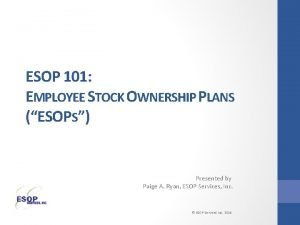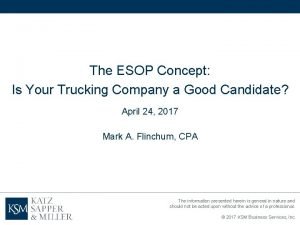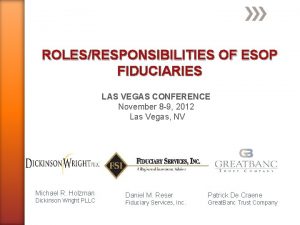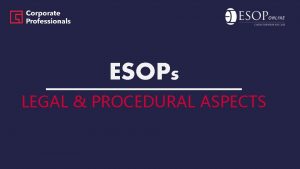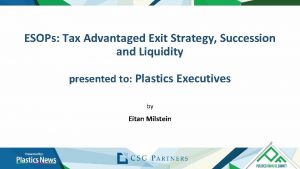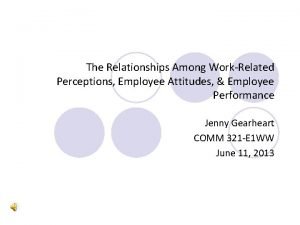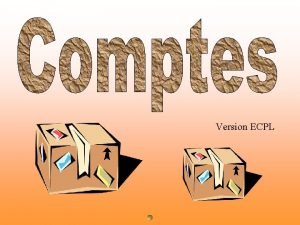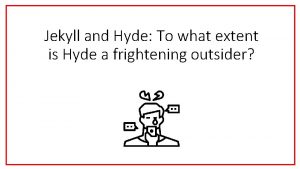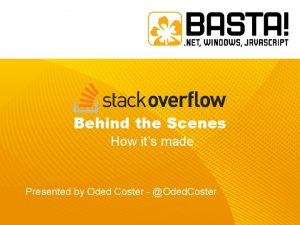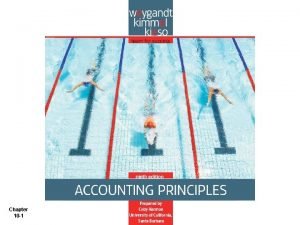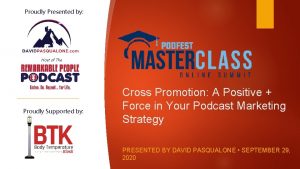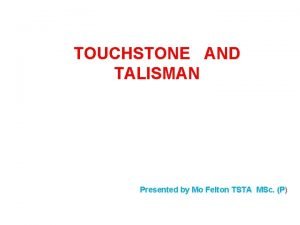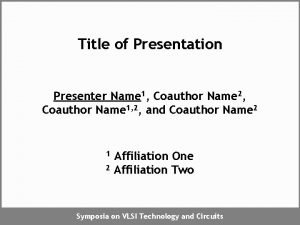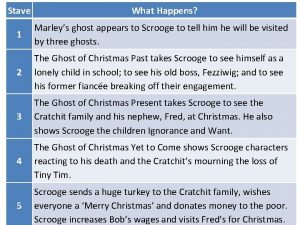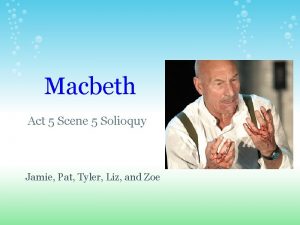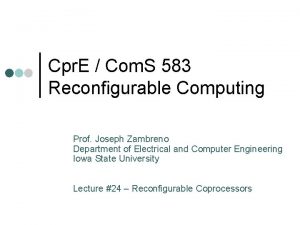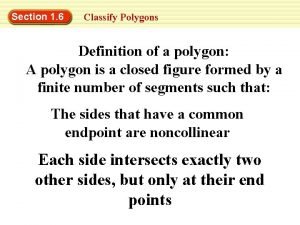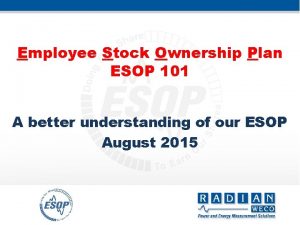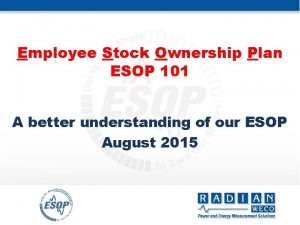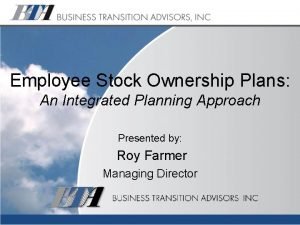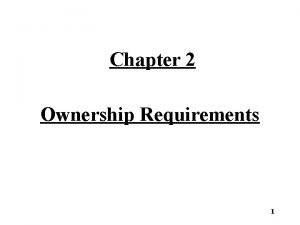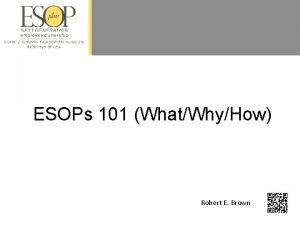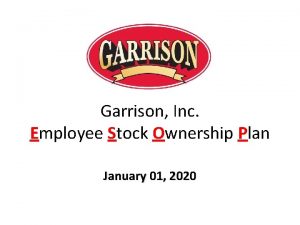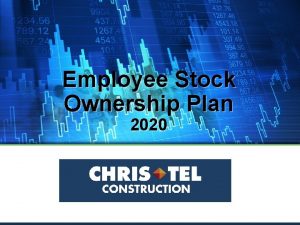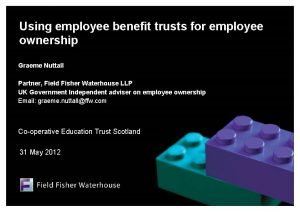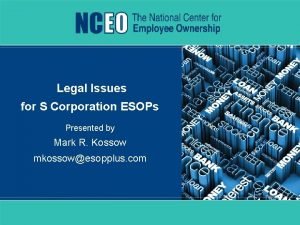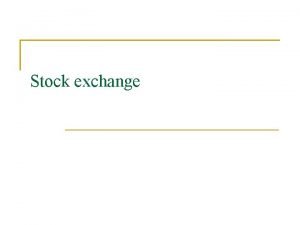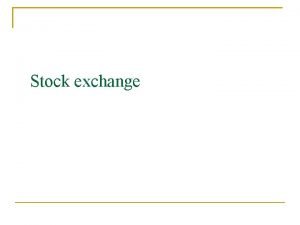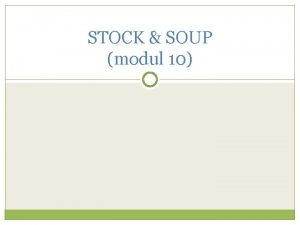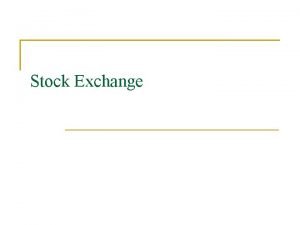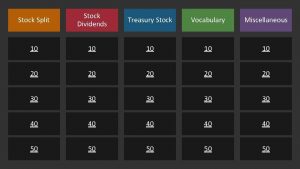ESOP 101 EMPLOYEE STOCK OWNERSHIP PLANS ESOPS Presented





















![TAX ADVANTAGES • Tax-deductible principal repayment [IRC 404(a)(9)] • Tax-free S corporation income [IRC TAX ADVANTAGES • Tax-deductible principal repayment [IRC 404(a)(9)] • Tax-free S corporation income [IRC](https://slidetodoc.com/presentation_image_h/ddc3bb52b56b490ff1d25f2ccd5837f8/image-22.jpg)














- Slides: 36

ESOP 101: EMPLOYEE STOCK OWNERSHIP PLANS (“ESOPS”) Presented by Paige A. Ryan, ESOP Services, Inc. © ESOP Services Inc. 2014

AGENDA • Why ESOPs? • • • What is an ESOP? ESOP history and facts ESOP mechanics Advantages and disadvantages The process and team Characteristics of an ESOP candidate 2

WHY ESOPS? • Liquidity in part or whole Converting shares into cash at a fair market value, creating liquidity, in part or whole, enabling the business owner(s) to diversify their portfolios • Perpetuation Selling shareholders stay involved, if desired • Maximum tax efficiency Shareholders, Company, Employees • Broadened ownership Employees incentivized to “think like owners” • Strategic planning Achieve shareholder and corporate objectives 3

AN ESOP IS A TRANSITION ALTERNATIVE Answers the question, “What are my alternatives for business perpetuation and creating liquidity? ” • • • Sale to third party Merger Sale to management Corporate stock redemption Initial public offering Gift or other transfer to heirs Wind-up business and liquidate Leveraged recapitalization Sale to Employee Stock Ownership Trust (potentially tax deferred with “tax-free” dollars) 4

OWNERSHIP – 100% TRANSFER PRIOR TO SALE Company POST SALE Company Shareholder 1 ESOP Shareholder 2 Participant Shareholder 3 Participant Employee Stock Ownership Plan Eligible employees become ESOP participants 5

Post Transaction Corporate Governance For a majority ESOP Nomination Committee Nominates Board of Directors for Trustee to Vote Nomination Committee Board appoints Audit Committee Board of Directors ESOP Committee Board appoints/removes Trustee(s) Manages Day to Day Operations of the ESOP Compensation Committee Company Corporate Governance Committee ESOP Sponsor * Trustee elects Directors from nominating committee’s slate 6

AGENDA • Why ESOPs? • What is an ESOP? • • • ESOP history and facts ESOP mechanics Advantages and disadvantages The process and team Characteristics of an ESOP candidate 7

AN ESOP IS A RETIREMENT PLAN • Qualified, defined contribution, employee benefit plan (ERISA) The plan is regulated by the government (IRS and DOL) • Invests primarily in the stock of the sponsoring company • “Qualified” in that sponsoring company, selling shareholders, and employee participants may receive various tax benefits The US government has given the company tax breaks for setting up the ESOP 8

Plan Design ESTATE PLANNING The ESOP Plan governs SHAREHOLDER LIQUIDITY LONG TERM STRATEGIC PLANS SELLER AND FAMILY WEALTH CAPITALIZATIO N THE ESOP PLAN Eligibility Participation Vesting Allocations / Forfeitures VALUATION Distribution Policy Pass-Through Voting Repurchase Obligation EMPLOYEE OWNERSHIP CULTURE CASH FLOW EMPLOYEE BENEFITS REPURCHASE OBLIGATION 9

AGENDA • Why ESOPs? • What is an ESOP? • ESOP history and facts • • ESOP mechanics Advantages and disadvantages The process and team Characteristics of an ESOP candidate 10

HISTORY OF ESOPS www. esopinfo. org

www. esopinfo. org

ESOP Companies More productive More profitable Higher survival rates esopassociation. org nceo. org esopinfo. org 14

AGENDA • Why ESOPs? • What is an ESOP? • ESOP history and facts • ESOP mechanics • Advantages and disadvantages • The process and team • Characteristics of an ESOP candidate 15

TRANSACTION DESIGN ALTERNATIVES • • • Non-leveraged Progressive Redemption and sale Leveraged Combination 16

Company NON –LEVERAGED Stock Shareholder(s) ESOP Accounts s re es r Sha ha d. S ed te cat ca lo Al Allo hare S ated Alloc s • Company sets up an ESOP Trust • Company makes annual tax deductible contributions in cash or stock to the ESOP trust • Cash is used to buy stock from current shareholders • Shares are allocated to the accounts of eligible employees within the ESOP, typically based on salary • ESOP holds stock for participants and annually notifies them of how much stock is in their account and the value of the stock in their account • Employees collect stock or cash, according to a vesting schedule, when they retire or otherwise leave the company 17 Former Participants

LEVERAGED ESOPS The ESOP receives a loan to purchase stock from current shareholders • These stock is held in trust and released into employee accounts at a rate corresponding to debt amortization FINANCING ALTERNATIVES ESOPs typically acquire a block of stock with leverage (“debt”) funded by one or a combination of: • Bank(s) • Excess company cash • Private equity group (PEG) • Selling shareholder(s) • Management investment (rare) • Broad-based employee investment (rare) • Combination (typical) 18

Company 100% LEVERAGED ESOP WITH SELLER DEBT (3) Contribution (1) ESOP buys stock from existing shareholders with a note (2) Shares are held in Suspense Account (3) Company makes annual tax-deductible contributions to ESOP to repay seller and bank debt (4) Shares are released from suspense account and allocated each year as ESOP repays sellers with contributions (5) Employees receive stock or cash when they retire or leave (vesting applies) (1) ESOP buys Stock with Note Suspense Account (4) Allocated Shares (2) Shares to Suspense Stock (4) All ocated Loan Payments Shareholder(s) ESOP Accounts (4) Allo cat ed Share s Sha res (5) Stock or Cash 19

100% LEVERAGED ESOP (BANK AND SELLER DEBT) Company $10 M VALUE $5 M BANK DEBT $5 M SELLER NOTES (1) $5 M Bank Loan to Company (7) Periodic Payment ($500 k) (1) Bank lends $5 M to company (2) Company lends $5 M to ESOP (7) $ K 500 me Pay nt (5) $1 M Contribution (7) $1 M Payment (4) Shares to Suspense Account ESOP Accounts Allocated Shares (3) ESOP buys stock with $5 M cash from bank and $5 M note (which is modified with company post closing) Alloc ated Allo cat ed (2) $5 M Co. Loan to ESOP Shar es Sha res (3) ESOP buys stock from existing shareholders (4) Shares are held in suspense account (5) Company makes annual taxdeductible contributions to ESOP to repay seller and bank debt (6) Shares are released from suspense account and allocated each year as ESOP repays company loan (7) The ESOP then repays company, who then repays the bank and sellers (8) Employees receive stock or cash when they retire or leave (vesting applies) Shareholders (8) Stock or Cash 20

HOW IS STOCK PRICE DETERMINED? BY LAW THE ESOP MAY NOT PAY MORE THAN FAIR MARKET VALUE AS DETERMINED BY AN INDEPENDENT VALUATION FIRM AND TRUSTEE Company’s stock price will be determined annually by the ESOP Trustee based on an independent valuation firm’s determination of fair market value • ESOP Trustee • Expertise in ESOP trustee services • Appointed to act on behalf of ESOP participants • Independent Valuation Firm • Independent and experienced in valuation • Utilize expertise, experience, industry standards, and guidelines provided by IRS 21

AGENDA • • Why ESOPs? What is an ESOP? ESOP history and facts ESOP mechanics • Advantages and disadvantages • The process and team • Characteristics of an ESOP candidate 22
![TAX ADVANTAGES Taxdeductible principal repayment IRC 404a9 Taxfree S corporation income IRC TAX ADVANTAGES • Tax-deductible principal repayment [IRC 404(a)(9)] • Tax-free S corporation income [IRC](https://slidetodoc.com/presentation_image_h/ddc3bb52b56b490ff1d25f2ccd5837f8/image-22.jpg)
TAX ADVANTAGES • Tax-deductible principal repayment [IRC 404(a)(9)] • Tax-free S corporation income [IRC 409(p) and 512(a)] • Tax-deferred sale - C corporation stock [IRC 1042] • Tax-deductible dividends “C” corporation [IRC § 404(k)] • Contributions may be reimbursable under federal government cost-plus contracts • ESOPs are frequently in addition to a 401(k) plan 23

ADVANTAGES Company • Substantial tax savings • Increased cash flow • Pre-tax dollars repay debt • Tax-free income, S Corp ESOP stockholder not subject to federal and most states mirror Stockholders • Liquidity in part or whole • IRC 1042 “tax-free” rollover • Selling shareholders can remain involved (if desired) Employees • Share in equity growth • Research shows ESOP companies more likely to have other retirement-oriented benefit plans • Proven motivator • Retains key employees 24

DISADVANTAGES • Requires debt to purchase larger blocks of stock • Seller can finance • Bank and bonding approval must be considered • Repurchase obligation • Planning for funding options important • The tax favors and employee benefits can be spectacular • Compliance with regulations: IRS, DOL, ERISA • Complexity • Experienced advisors essential 25

PERPETUATION PLANNINGC CORPORATION IRC 1042 “TAX-FREE ” ROLLOVER • Seller must have owned stock for at least three years prior to sale: • Seller cannot have acquired the stock in a compensatory stock option plan or any other section 83 transaction, nor from a qualified retirement plan • Seller, certain related individuals, and greater-than-25% owners generally cannot participate in ESOP allocations • 10% excise tax applies if ESOP disposes of stock within three years, except for normal benefit distribution • Above rules do not apply if seller does not elect the “tax-free” rollover 26

PERPETUATION PLANNINGC CORPORATION IRC 1042 “TAX-FREE ” ROLLOVER • Seller must have owned stock for at least three years prior to sale: • Seller cannot have acquired the stock in a compensatory stock option plan or any other section 83 transaction, nor from a qualified retirement plan • Seller, certain related individuals, and greater-than-25% owners generally cannot participate in ESOP allocations • 10% excise tax applies if ESOP disposes of stock within three years, except for normal benefit distribution • Above rules do not apply if seller does not elect the “tax-free” rollover 27

TAX STATUS CONVERSION • C to S or S to C • IRC 1042 “tax-free” rollover as C Corporation transaction, then convert to S Corporation • S Corporation convert to C for “tax-free” Rollover – five-year wait to convert to S • 100% shareholder approval for S Corporation election 28

AGENDA • • • Why ESOPs? What is an ESOP? ESOP history and facts ESOP mechanics Advantages and disadvantages • The process and team • Characteristics of an ESOP candidate 29

THE PROCESS Preliminary Analysis Phase I Decision Package Phase II Implementation Phase III Ongoing • No cost • Confidential • 30, 000 foot view • Valuation estimate • Feasibility study, creating a “decision package” • Plan and trust, and transaction documents • Financing • Repurchase obligation planning/funding • Independent transaction valuation • Employee communications • Repurchase obligation • Annual administration and valuation 30

ESOP TEAM • Trusted advisors • ESOP consultant • Prepares feasibility study, the decision package, to ascertain viability and “quarterbacks” implementation • Corporate counsel and CPA, other advisor(s) • Supporting and advising as needed • Third party plan administrator • Handles annual record keeping and compliance testing • Independent appraiser • Determines fair-market value • Trustee(s) • Acts on behalf of the ESOP and purchases stock • ESOP counsel • Drafts plan, trust and transaction documents • Advises trustee(s) and other fiduciaries 31

AGENDA • • • Why ESOPs? What is an ESOP? ESOP history and facts ESOP mechanics Advantages and disadvantages The process and team • Characteristics of an ESOP candidate 32

“IDEAL ”CANDIDATE “C” or “S”- corporation, LLC’s can convert History of good cash flows Stock is privately held Shareholder interest in liquidity/diversification Sufficient payroll Debt capacity Shareholder interest in maintaining legacy of business and employee continuity • Solid successor management team with interest in stock • • 33

IS AN ESOP RIGHT FOR YOU , AND YOUR COMPANY ? 34

THE ANSWER : IT DEPENDS … • On shareholder goals and objectives • Estate planning, personal financial needs, time table, control • Business’s Strategic Plan • Projected growth, successor management, cash flow, employee benefits levels, ownership culture • Current economic considerations • Valuation, transaction financing, tax implications, current legislative environment 35

NEXT STEPS • Learn more • www. esopservices. com • References • Selected upon request • Partial list at www. esopservices. com/reference. html • Preliminary Analysis • Call or email with questions! 36

ESOP Services, Inc. www. esopservices. com Founded in 1984, ESOP Services, Inc. responds to the needs of business owners to understand analyze the ESOP’s impact on the company, shareholders, and employees, focusing on the financial aspects of cash flow, tax savings, shareholder liquidity, and employee benefits. We specialize in all aspects of Employee Stock Ownership Plans for both private and public companies throughout the United States and internationally. Our unique approach emphasizes the financial aspects of ESOPs, while coordinating the many diverse elements necessary to successfully establish an ESOP. Paige Ryan San Diego, CA 92142 Phone: 858. 292. 4819 paige@esopservices. com Ron Gilbert Scottsville, VA 24590 Phone: 434. 286. 3130 esop@esopservices. com 37
 Esop 101
Esop 101 Esop trucking companies
Esop trucking companies Esop conference 2019 las vegas
Esop conference 2019 las vegas Unit appreciation rights
Unit appreciation rights Csg esop
Csg esop Employee attitudes and employee performance
Employee attitudes and employee performance Phantom stock plans pros and cons
Phantom stock plans pros and cons Features of preferred stock
Features of preferred stock Teknik pembuatan white stock sesuai dengan standar
Teknik pembuatan white stock sesuai dengan standar Characteristics of corporate bonds and stocks
Characteristics of corporate bonds and stocks Stock final de marchandises
Stock final de marchandises Love and hate theme
Love and hate theme Introduction to conic sections
Introduction to conic sections Hyde as an outsider
Hyde as an outsider How it's made presented by
How it's made presented by Professionally presented
Professionally presented Ordinary repairs
Ordinary repairs Main headline
Main headline The technological design model is presented as a
The technological design model is presented as a Significant cigarettes igcse
Significant cigarettes igcse Rgb presenters
Rgb presenters Proudly presented by
Proudly presented by Ozymandias and london venn diagram
Ozymandias and london venn diagram Family feud presented by
Family feud presented by Talisman presented
Talisman presented Natural asset companies
Natural asset companies As presented below
As presented below Presentation name
Presentation name Bob cratchit quotes
Bob cratchit quotes Presented sy
Presented sy Ozymandias narrator
Ozymandias narrator Macbeth soliloquy act 5
Macbeth soliloquy act 5 Prism is presented with
Prism is presented with The element of music that organizes movement in time is:
The element of music that organizes movement in time is: Topic main idea and supporting details examples
Topic main idea and supporting details examples Identify the type of polygon
Identify the type of polygon Technical drawing introduction
Technical drawing introduction
